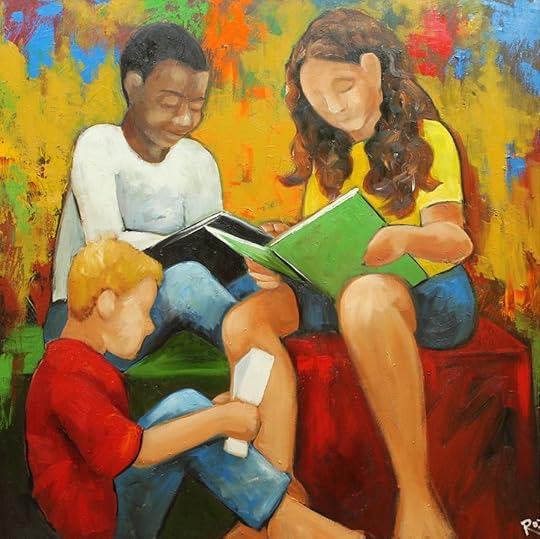PLEASE READ: To Any Child You Know…
Why am I blessed with certain values? Why do I often do research first, before making a decision about almost anything? Why am I able to consider points of view before loving or condemning an outcome? Why, while relating to people I have never met, I can usually find a common topic to discuss? And why do I love the diversity that IS American culture?
Answer: Because I grew up in a home where reading was not only necessary, it was wonderful! My mother made sure I could read, I had access to books and print materials. Thus as I grew, I learned to love reading: books, newspapers, magazines, and now online essays, articles, blog posts and newsmagazines.
Any family member can read to a younger child, excite that child about the power of reading and thus help that child learn the reading habit, the love of reading. And it can start with a variety of media. But books for children–that’s the best place to start.
THE READING HABBIT (or just skip to the list below)
Many children’s stories are magical and enduring, conveying ideas, moral messages while stimulating thinking and imagination. Children’s books do this by creating characters a child loves, sees himself or herself in the narrative situation. Children’s books do this through the wonder of imagination and if there is a message, it’s subtle, your child or grandchild, nephew, niece, friend, turning to you and saying–“I’m glad she shared, in the end.” Or–“I know how he felt when the father said that.”
When you read to a child, they immediately pick up on ideas, the message. They always ask questions, often are emotionally touched. Reading children’s books can serve as preparation for more complex literature and more complex ideas later in life. It can also simply help a child see morality or new ideas in action. Childhood is preparation for LIFE. And childhood, when we look back on ours, can be fleeting. We need to help them get ready…
If you search for “children’s books” many familiar titles appear. The following are not brand-new, but older treasurers: Good Night Moon, A Wrinkle in Time, The Tale of Peter Rabbit, Charlie and the Chocolate Factory, Charlotte’s Web, Where the Wild Things Are…
NOW FOR SOMETHING NEWER…
Under an article, 100 Best Children’s Books, here are some newer listings that made me smile…
Dream Big, Little One by Vashti Harrison (Baby to 3 years) Presents 18 encouraging pioneers, including Bessie Coleman, a pilot.
And Tango Makes Three by Justin Richardson and Peter Parnell (2-5) The tender story of two boy penguins who become a couple and start a family. It’s an LGBTQ book, predicted to warm the heart and open the mind.
An old favorite: The Snowy Day by Ezra Jack Keats (2-5) This is a classic that I read to my children, being “groundbreaking in its depiction of multicultural urban life. The writer takes a simple experience, exploring a recent snow fall, and adds wisdom and wit—and quietly emphasizes how life should be.
The Story of My Open Adoption by Leah Campbell. This book explores the complex layers of open adoption…introduces little ones to the many varieties of families. Story line: an adopted child goes with his rabbit parents to meet his squirrel first family.
Fry Bread: A Native American Family Story by Kevin Noble Maillard (3-6) This lovely story presents a Native American family cooking fry bread. The story is poetic as it reveals everything food and tradition means to family.
We Are Water Protectors by Carole Lindstrom (3-6) This book won the Caldecott Medal, has lovely artwork and the poetic story presents an ecological message about water preservation. It also focusses on our land and its connection to Indigenous cultures.
Chalk by Bill Thomsom (3-7) This 2010 picture book provides children with images that tell a story without words. Three fiends find a bag of chalk. They draw pictures that come to life! But then the pictures start to cause problems. The children must draw the solutions!!
The Name Jar by Yangsook Choi (3-7) Published in 2001, teachers have used it, because it provides a powerful message of acceptance and personal strength. Unhei has moved from Korea and is now living in the U.S. The children in her school can’t pronounce her name. Will she choose an American name, or find the courage to honor her roots and identity?
Two Homes by Claire Masurel (3-7) This is a story about children having two homes because their parents are divorced or separated. They learn that different doesn’t mean worse and that they can find comfort and love in both places.
Don’t Touch My Hair! By Sharee Miller (4-7) This story teaches a wonderful lesson about personal boundaries, Aria is young, Black with curls and everywhere she goes, folks want to touch her hair. Through her imagination she learns to stand up for herself.
All of these books are included in a Reader’s Digest piece: 100 Best Children’s Books of All Time. I have listed ones that help children with inclusivity. There are many other titles that you will recognize, books you probably read to your children: The Velveteen Rabbit, Winnie the Pooh, Madeline, The Very Hungry Caterpillar…
Maybe you still have a bookcase with weathered and old favorites. Now all you need is to find a child to read them to…
Art Work: Rosilyn Young
Thanks to: https://www.rd.com/list/the-best-childrens-books-ever-written
Facebook Twitter LinkedInPinterest



